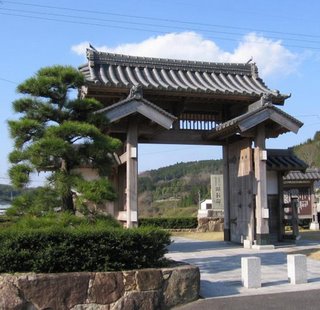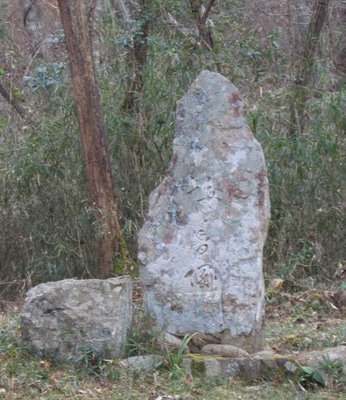:::::::::::::::::::::::::::::::::::::::::::::::::::::::::::::::::::::::::::::::::::::::::::::::::::::
Izumo Kaido, Doi Town
Mimasaka, Doi Juku
出雲街道 美作市土居宿
Doi is one of the seven postal towns of the former Mimasaka province, the first when coming down from the pass Man no Tawa from the Himeiji region, former Harima province 播磨国.
The walk starts from the replica of the old toll gate, now close to the station.
The Western Toll Gate, Saisoo Mon 西惣門
It has been build in the period from 1596 to 1614

This gate stands at the border of Eastern and Western Japan as preceived in the Edo period and was especially large. Doi was a bustling town with many lodgings for the travellers. It had a reserve of 2500 day laborours and 5 horses.
The town was rather well known and even the place of a novel by the famous Soma Ryotaro. The story told about an episode of four samurai, who got mugged on the road and had their official money stolen, causing their death by harakiri at this spot. The samurai's names got cleared later and the villagers build them a grave with a large memorial stone to apease their souls, 勤皇志士の墓.
It has been rebuild in its old Korean style, measuring 4,5 meters in hight and is 7,8 meters wide.
Doi juku ya fuyu no sora ni warau oni
土井宿や 冬の空に 笑う鬼
old postal town -
a demon grins
in the winter sun

and the shachihoko decoration sparkles

.................................................................................
The metal fitting of the old gate look almost like a crocodile mouth.
Or dragon mounth, come 2012 !

A plate showing the old town of Doi.
Look at it here !
Most of the old houses are lost, but in memory there are many plates reminding us of the most famous ones. Here is Izumiya.
The little colorful figure on the right is a bearer of a Feudal Lord's procession, called YAKKO (reference see below).

Enchanting Patterns found in Doi
Enchanting Trees found in Doi
Dragon branches and clouds
From the toll gate our walk took us through the straight road, about 700 meters long, but not many of the old homes are well preserved.
:::::::::::::::::::::::::::::::::::::::::::::::::::::::::::::::::::::::::::::::::::::::::::::::::::::

Jizo, protector of children
:::::::::::::::::::::::::::::::::::::::::::::::::::::::::::::::::::::::::::::::::::::::::::::::::::::
Toward the end of the main road was a fork to the local shrine,
Doi Jinja 土井神社.
god's wisteria
all bend and twisted and
full of life
Look at it HERE !
Komainu 狛犬
The Watchful Stone Dog ! Look !
The Water sprouting Dragon ! Look !
and more about water sprouting dragons
龍の口から水の出る手水鉢
The Votive Plaque with a Crane for Good Luck ! Look !

The Asiatic Lunar Zodiac Plate, a very rare sight at this spot!
A stone revered as a Shinto Deity

ooo ooo ooo ooo ooo ooo ooo ooo ooo ooo ooo ooo
Man no Tawa, the Old Pass to the Harima Province
万能乢 万の乢
(たわ垰、an old word for tooge とうげ 峠 ).
Hiking along the small road at the side of the school the walk reaches out of the twon and into the fields.
A lot of old stone graves on the slope stand there in memory of the weary travellers of old.
Look at them HERE !
Finally crossing the modern raiway line, we came to the entrance of the old forest road to the pass.

The walk is rather pleasant up the hill. Look !
In the middle of nowhere there is a sign and then a stone memorial in rememberance of Matsuo Basho !
The "Fragrant Plum Memorial", baikazuka, umekazuka 梅香塚.
In the year 1793, the local haiku master of Doi invited other haiku friends to celebrate the 100th death day of Matsuo Basho (1644-1694) with the erection of a stone monument with one of his haiku:
ume ga ka ni notto hi no deru yamaji kana
梅が香にのっと日の出る山路かな
in the fragrance of plum blossoms
the sun comes out
on this mountain path . . .
Tr. Gabi Greve

Basho published this haiku in the year 1694 in the collection A Sack of Charcoal (Bag of Charcoal) (Sumidawara 炭俵).
This hokku has the cut marker KANA at the end of line 3.
The area here was known for the beautiful mountain crossing of this pass.
Suddenly the sun rose,
To the scent of the plum-blossoms
Along the mountain path.
Tr. Blyth
On sweet plum blossoms
The sun rises suddenly.
Look, a mountain path!
Tr. Buchanan
In the plum blossom scent
the sun pops up --
a mountain path
Tr. Shirane
The cut marker KANA is at the end of line 3.
- Matsuo Basho and
. - ume ga ka 梅が香 plum fragrance - .
Explaining the place in Japanese. Photo.
Climbing up a bit more. Look !
Winterwald -
neues Leben spriesst
aus altem
English and Photo are HERE !
Finally we reached the pass. The wooden markers make you feel right back to the Edo period:
To the right, the Harima Procince, to Himeji 15 ri
To the left, Sakushu Province, to Tsuyama 20 ri

Thus we reached the end of our tour for the day.
We hope to be back soon on the Old Road of Izumo.
:::::::::::::::::::::::::::::::::::::::::::::::::::::::::::::::::::::::::::::::::::::::::::::::::::::
Reference, with LINKS to my own stories:
YAKKO and Daruma 奴だるま
The Asian Lunar Calendar and Zodiac
BACK TO
The Old Road of Izumo
:::::::::::::::::::::::::::::::::::::::::::::::::::::::::::::::::::::::::::::::::::::::::::::::::::::
. Photo Album - DOI .
[ . BACK to DARUMA MUSEUM TOP . ]
[ . BACK to WORLDKIGO . TOP . ]
:::::::::::::::::::::::::::::::::::::::::::::::::::::::::::::::::::::::::::::::::::::::::::::::::::::








1 comment:
http://www.pref.okayama.jp/sangyo/kanko/rekishi100/043/043.htm
出雲街道旧道を歩いてみました。
何かとても懐かしい思いがします。
恐らく遠い祖先が朝鮮から来て都へ、この道を通ったのでしょう。
有難うGabi san
sakuo
Post a Comment